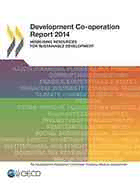Table Of ContentDevelopment Co-operation Report 2014
Mobilising ResouRCes foR sustainable DevelopMent
Development Co-operation
Contents
Editorial: More and better financing for development
Report 2014
Executive summary
Chapter 1. How to better mobilise resources for sustainable development
PART I. Existing sources of financing for sustainable development Mobilising ResouRCes
Chapter 2. Keeping ODA focused in a shifting world
foR sustainable DevelopMent
Chapter 3. Growing dynamism in South-South co-operation
Chapter 4. The growing development potential of other official flows
Chapter 5. Putting foreign direct investment to work for development D
e
Chapter 6. Are institutional investors the answer for long-term development financing? v
e
Chapter 7. Tax revenues as a motor for sustainable development lo
p
Chapter 8. Foundations as development partners m
Chapter 9. The changing role of NGOs and civil society in financing sustainable development e
n
Chapter 10. What place for remittances in the post-2015 framework? t C
o
paRt ii. Mechanisms for increasing resources for sustainable development -
o
p
Chapter 11. Using financial instruments to mobilise private investment for development
e
r
Chapter 12. Creating an environment for investment and sustainable development a
t
Chapter 13. Fighting corruption and illicit financial flows io
n
Chapter 14. Supporting countries in growing their tax base R
Chapter 15. Innovating to finance development e
p
Chapter 16. Enhancing the contribution of social business to sustainable development o
r
t
paRt iii. Development finance post-2015 and the provision of global goods 2
0
1
Chapter 17. How can development co-operation address global challenges? 4
Chapter 18. Finding synergies for environment and development finance M
o
Chapter 19. Financing peace and security for sustainable development b
il
Chapter 20. Backing recovery in fragile states is
in
Chapter 21. Supporting a fair and equal trading system g
R
e
paRt iv. profiles of development co-operation providers s
o
u
Trends in Development Assistance Committee members’ development co-operation: R
C
A synthesis of peer reviews, 2012-14 e
s
Development Assistance Committee members’ ODA performance in 2013 f
o
R
Profiles of Development Assistance Committee members s
u
Trends and profiles of other providers’ development co-operation s
t
a
Annex A. Statistical annex in
a
Annex B. Methodological notes on the Profiles of Development Assistance Committee members b
l
Annex C. Technical notes on definitions and measurement e D
e
v
e
l
o
p
M
Consult this publication on line at http://dx.doi.org/10.1787/dcr-2014-en.
e
n
t
This work is published on the OECD iLibrary, which gathers all OECD books, periodicals and statistical databases.
Visit www.oecd-ilibrary.org for more information.
The Development Assistance Committee: Enabling effective development
isbn 978-92-64-21091-2
9HSTCQE*cbajbc+
43 2014 03 1 p
Development
Co-operation Report
2014
MOBILISING RESOURCES
FOR SUSTAINABLE DEVELOPMENT
ThisworkispublishedundertheresponsibilityoftheSecretary-GeneraloftheOECD.The
opinionsexpressedandargumentsemployedhereindonotnecessarilyreflecttheofficial
viewsofOECDmembercountries.
This document and any map included herein are without prejudice to the status of or
sovereigntyoveranyterritory,tothedelimitationofinternationalfrontiersandboundaries
andtothenameofanyterritory,cityorarea.
Pleasecitethispublicationas:
OECD(2014),DevelopmentCo-operationReport2014:MobilisingResourcesforSustainableDevelopment,
OECDPublishing.
http://dx.doi.org/10.1787/dcr-2014-en
ISBN978-92-64-21091-2(print)
ISBN978-92-64-21601-3(PDF)
ISBN978-92-64-22075-1(HTML)
Annual:DevelopmentCo-operationReport
ISSN2074-773X(print)
ISSN2074-7721(online)
Revisedversion,November2014
Detailsofrevisionsavailableat:www.oecd.org/about/publishing/Corrigendum-DCR-2014.pdf.
ThestatisticaldataforIsraelaresuppliedbyandundertheresponsibilityofthe relevantIsraeliauthorities.Theuse
ofsuchdatabytheOECDiswithoutprejudicetothestatusoftheGolanHeights,EastJerusalemandIsraeli
settlementsintheWestBankunderthetermsofinternationallaw.
CorrigendatoOECDpublicationsmaybefoundonlineat:www.oecd.org/about/publishing/corrigenda.htm.
©OECD2014
ExceptforcontentinBox11.2onpage139underCopyright[2014]InternationalFinanceCorporation.
Youcancopy,downloadorprintOECDcontentforyourownuse,andyoucanincludeexcerptsfromOECDpublications,databasesand
multimediaproductsinyourowndocuments,presentations,blogs,websitesandteachingmaterials,providedthatsuitable
acknowledgmentofthesourceandcopyrightownerisgiven.Allrequestsforpublicorcommercialuseandtranslationrightsshouldbe
submittedtorights@oecd.org.Requestsforpermissiontophotocopyportionsofthismaterialforpublicorcommercialuseshallbe
addresseddirectlytotheCopyrightClearanceCenter(CCC)[email protected]çaisd'exploitationdudroitdecopie
(CFC)[email protected].
FOREWORD
Foreword
by
AngelGurría,OECDSecretary-General
T
he OECD has been working on the definition and monitoring of official development assistance (ODA) and
other official flows for development. Most recently, we have been leading global efforts to ensure that official
developmentfinanceisfit-for-purposeintoday’squicklyevolvingdevelopmentlandscape:wearemodernising
ourdevelopmentfinancestatisticalsystemsandrevisingthedefinitionofwhatqualifiesasODA.
Although ODA has recently reached record levels – despite budgetary constraints in many
OECDcountries– its relative importance is shrinking in comparison to other flows and resources. Nowadays,
developing countries have more access to alternative sources of finance than ever before, including through
privateinvestmentandco-operationamongdevelopingcountries.Itisfundamentaltoensurethatpublicfunds
arespentinasmartandstrategicmanner,andthattheyareusedtomobiliseothersourcesoffinancetocover
theincreasinglycomplexdemandsofsustainableglobaldevelopment.
AttheOECD,weareusingourwiderangeofexpertisetomobiliseresourcesforsustainabledevelopment.
TwoyearsagoweputinplaceanambitiousStrategyonDevelopmenttoleverageourcumulativeexperienceand
expertise. Among many concrete initiatives, we are playing an important role in promoting foreign direct
investmentininfrastructure,whichisdesperatelyneededinmanydevelopingcountriesandcompletelyleftout
of the Millennium Development Goals (MDGs). We also continue to look for new ways of capturing green
investmentandpromotingrelevantpolicyframeworkstoensurethatgrowthandenvironmentgoalsgohandin
hand. Likewise, we are helping developing countries to finance their own development by improving their
taxationsystemsandpracticesthroughinitiativeslikeTaxInspectorsWithoutBorders,aswellasbyavoiding
thelossoffundsduetocorruptionandillicitfinancialflows.Andwearecontributingtoglobaleffortstoexplore
howremittances,socialbusinessandphilanthropicinitiativescansupportsustainabledevelopmentinthemost
effectiveway.
Yet, we recognise that for many countries– particularly those beset by conflict and fragility– ODA will
continuetoplayavitalrole,andwearelookingathowtochannelanincreasedshareofODAtothecountries
mostinneed.Thisisparticularlyimportantgiventhetrendwehaveseenoverthepastthreeyearsofdeclining
levelsofODAgoingtothecountriesmostinneed,includingsub-SaharanAfricaandmanyfragilestates.
Ending poverty, preserving the environment, combatting climate change, ensuring peace and security,
increasingresilience,andestablishingafairandequaltradingsystemarenolongernationalissues.Theyare
challengesthatmustbeaddressedandsupportedatthegloballevel.
TheUnitedNationsisleadingtheefforttoestablishthenewsetofSustainableDevelopmentGoalsthatwill
guideusbeyond2015,thedeadlineforthepresentsetofMDGs.Mobilisingabroadmixofresourcesiscrucial
forthepost-2015world,wheredevelopmentgoalswillovercomethedevelopment-environmentdivide,merging
intoasingleglobalframeworkforsustainabledevelopment.Fundingthesenewgoalswillrequireinputsfrom
acrosstheboard–frompublicandprivatesourcesandfromallcommunitiesandcountries.
DEVELOPMENTCO-OPERATIONREPORT2014©OECD2014 3
FOREWORD
TheOECDwillcontinuetobecentraltothisendeavour,bymonitoringandtrackingtheresourcesneededto
realise these goals. Perhaps more important, we will also apply our expertise to support the policies that will
make change happen. This Development Co-operation Report (DCR)2014 illustrates our commitment to
theseobjectives.
AngelGurría
OECDSecretary-General
4 DEVELOPMENTCO-OPERATIONREPORT2014©OECD2014
CREDITS
Credits
ReportbyErikSolheim,DACChair
Conceptual and project leader
HildegardLingnau
Lead analyst
JuliaSattelberger
Part IV analysts
IdaMcDonnell(leadanalyst)
YasminAhmad
WillemLuijkx
RahulMalhotra
JulieSeghers
Statistical annex lead analyst
YasminAhmad
Managing editor
ChristineGraves
Copy editor
FionaHinchcliffe
Proof reader
JenniferAllain
Production manager
ElizabethDelBourgo
Co-ordination for the DAC Chair’s Office
ErlendHaugen
Cover design
StephanieCoïc
The team wishes to thank all others who played a part in producing the DCR2014 and regrets any
omissions.
DEVELOPMENTCO-OPERATIONREPORT2014©OECD2014 5
TABLEOFCONTENTS
Table of contents
Acronymsandabbreviations .......................................................... 17
Editorial:Moreandbetterfinancingfordevelopment..................................... 19
byErikSolheim
Executivesummary .................................................................. 23
Chapter1.Howtobettermobiliseresourcesforsustainabledevelopment ................... 27
byRaundiHalvorson-Quevedo,HildegardLingnauandJuliaSattelberger
Abroaderagendawillrequirebroaderfinance........................................ 29
WherewillthefinancingfortheglobalSustainableDevelopmentGoalscomefrom?....... 29
Inmyview:Korea’suseofODAcanguideothercountriesintheirdevelopment,
byYunByung-se................................................................... 30
SmartODAcanhaveamultipliereffect.............................................. 32
Thetimeforideasisnow.......................................................... 34
Notes ........................................................................... 34
References....................................................................... 34
PartI
Existingsourcesoffinancingforsustainabledevelopment
Chapter2.KeepingODAfocusedinashiftingworld....................................... 39
bySuzanneSteensen
Therearelargedifferencesindevelopingcountries’needsandaccesstofinance.......... 40
TherelativeimportanceofODAisdiminishing,butnoteverywhere..................... 44
LeastdevelopedcountriesarethemostdependentonODA ............................ 44
Middle-incomecountriesstillfacemanydevelopmentchallenges....................... 44
Inmyview:TheStructuralGapapproachoffersanewmodelforco-operationwithmiddle-income
countries,byAliciaBárcena .......................................................... 45
ODAgrowthisslowinginthosecountriesthatneeditmost ............................ 46
Inmyview:HalfofallODAshouldgototheleastdevelopedcountries,
byGyanChandraAcharya........................................................... 47
Officialfinancemustbeusedtoitsgreatestpotential.................................. 48
Keyrecommendations ............................................................ 49
Notes ........................................................................... 49
References....................................................................... 49
DEVELOPMENTCO-OPERATIONREPORT2014©OECD2014 7
TABLEOFCONTENTS
Chapter3.GrowingdynamisminSouth-Southco-operation ............................... 51
bySachinChaturvedi
South-Southco-operationisremodellingthedevelopmentfinancelandscape ............ 52
South-Southco-operationisfoundedonequityandmutualbenefit ..................... 56
Keyrecommendations ............................................................ 57
Notes ........................................................................... 57
References....................................................................... 57
Chapter4.Thegrowingdevelopmentpotentialofotherofficialflows ....................... 59
byAlexanderKlein,CécileSangaréandGiovanniMariaSemeraro
Otherofficialflowsaregainingimportanceinthedevelopmentfinancelandscape ........ 60
Internationalfinancialinstitutionsarebyfarthelargestprovidersofotherofficialflows... 62
Developmentfinanceinstitutionshelpfillthegapbetweenpublicaid
andprivateinvestment............................................................ 64
Officiallysupportedexportcreditscanbecriticalforfinancinglargeprojects
indevelopingcountries............................................................ 66
Keyrecommendations ............................................................ 68
Notes ........................................................................... 68
References....................................................................... 69
Chapter5.Puttingforeigndirectinvestmenttoworkfordevelopment....................... 71
byMichaelGestrin
Foreigndirectinvestmenttodevelopingcountriesisontherise......................... 72
Chinaaccountsforalargeshareofbothinwardandoutwardforeigndirectinvestment.... 74
Africareceivesthelowestshareofforeigndirectinvestment ........................... 74
Investmentappearstobe“de-globalising” ........................................... 75
Howcanthepositiveaspectsofforeigndirectinvestmentbeharnessed?................. 78
Keyrecommendations ............................................................ 78
Notes ........................................................................... 78
Chapter6.Areinstitutionalinvestorstheanswerforlong-termdevelopmentfinancing?...... 79
byRaffaeleDellaCroce
Institutionalinvestmentisontherise............................................... 81
Policyreformcanremovebarrierstoinstitutionalinvestment .......................... 84
Inmyview:TheOECDmusttakechargeofpromotinglong-terminvestmentindevelopingcountry
infrastructure,bySonyKapoor........................................................ 85
Keyrecommendations ............................................................ 88
Notes ........................................................................... 88
References....................................................................... 88
Chapter7.Taxrevenuesasamotorforsustainabledevelopment........................... 91
byGregoryDePaepeandBenDickinson
Taxationplaysacentralroleinpromotingsustainabledevelopment..................... 92
Developingcountriesface“taxing”challenges........................................ 93
Inmyview:Africacanfunditsownsustainabledevelopment,byAbdallaHamdok............. 95
Thedevelopmentcommunitycoulddomoretosupporttaxsystems .................... 96
Keyrecommendations ............................................................ 97
Notes ........................................................................... 97
References....................................................................... 97
8 DEVELOPMENTCO-OPERATIONREPORT2014©OECD2014

